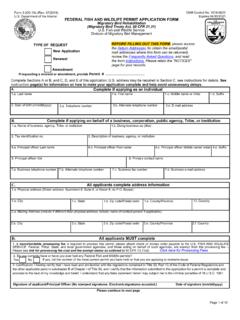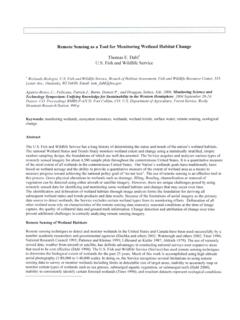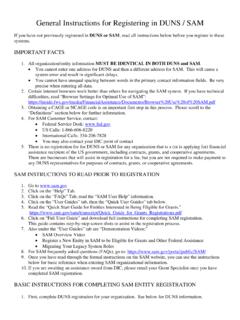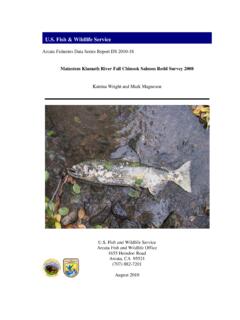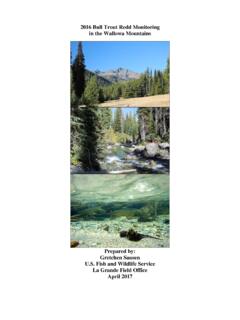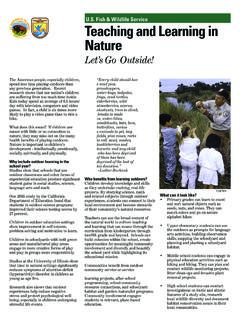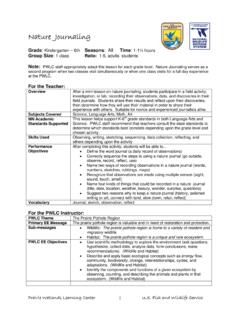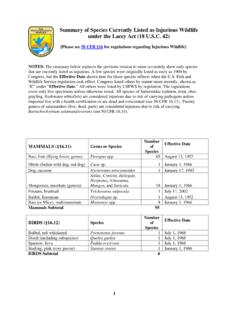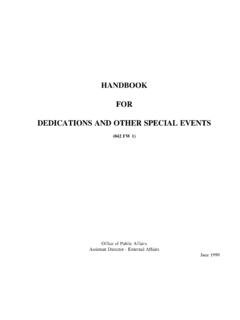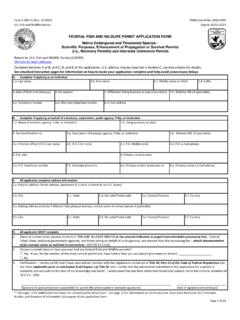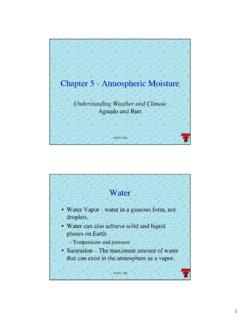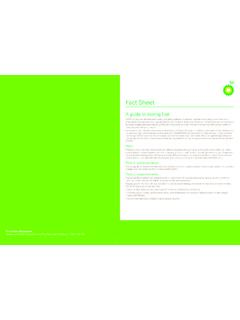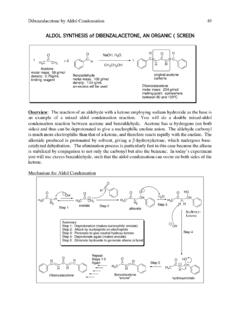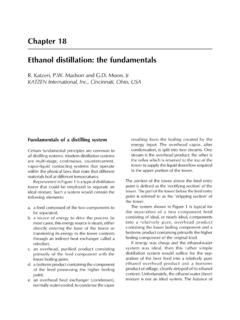Transcription of Chapter 5 - Bacteriology - FWS
1 NWFHS Laboratory Procedures Manual - Second Edition, June 2004 Chapter 5 - Page 1 Chapter 5 Bacteriology Jason Woodland USFWS - Pinetop Fish Health Center Pinetop, Arizona NWFHS Laboratory Procedures Manual - Second Edition, June 2004 Chapter 5 - Page 2 I. Introduction This section defines the procedures and techniques used to correctly identify the target bacterial pathogens identified for the Survey (Yersinia ruckeri, Aeromonas salmonicida and Edwardsiella ictaluri). Proper identification relies on bacterial growth characteristics, appropriate biochemical tests, and corroboration by serological techniques. Pathogens of Regional Importance (PRIs) include: Citrobacter freundii, Edwardsiella tarda, Flavobacterium columnare and Flavobacterium psychrophilum.
2 The later two bacteria have special requirements for culture and serological confirmation. Several excellent sources are listed in the Reference section for identification of PRIs and other bacteria that may be isolated from fish sampled for the Survey. Additional media formulas are also provided for PRIs in Appendix A. Thanks to Phil Hines of the USFWS, Pinetop Fish Health Center, Pete W. Taylor of the USFWS, Abernathy Fish Health Center and Clifford E. Starliper of the USGS, National Fish Health Laboratory for their input into this second edition of the Bacteriology Chapter . II. Media Preparation A. PLATE MEDIA 1. Prepare media in stainless steel beakers or clean glassware according to manufacturer instructions. Check pH and adjust if necessary.
3 Media must be boiled for one minute to completely dissolve agar. Common media recipes are given in Appendix A. 2. Cover beaker with foil, or pour into clean bottles being sure to leave lids loose. Sterilize according to manufacturer s instructions when given, or at 121 C for 15 minutes at 15 pounds pressure. 3. Cool media to 50 C. 4. Alternatively, media can be autoclaved and cooled to room temperature and refrigerated for later use. Store bottles labeled with media type, date and initials. When media is needed, boil, microwave or use a water bath to completely melt the agar. Cool to 50 C, then proceed to step 5. 5. Before pouring media, disinfect hood or counter thoroughly and place sterile petri dishes on the disinfected surface. 6. Label the plates or plate storage tins with the type of medium, preparers initials, and date made.
4 NWFHS Laboratory Procedures Manual - Second Edition, June 2004 Chapter 5 - Page 3 7. Remove bottle cap and pour plates or dispense with a Cornwall pipette, lifting each petri dish lid as you go. Pour approximately 15 to 20 mL per 100 15 mm petri dish. Replace lids as soon as the plate is poured. 8. Immediately after use, rinse the automatic pipettor in hot tap water followed by distilled water to remove all media and prevent clogging of the instrument. 9. Invert plates when the media has cooled completely (~ 30-60 minutes) to prevent excessive moisture and subsequent condensation on the plate lid. Do not use the UV light because it can denature the proteins in the media. 10. Allow plates to sit overnight at room temperature. Store plates upside down in the refrigerator in a tightly sealed plastic bag or plate storage tin.
5 11. Follow manufacturer s recommendation for storage period of prepared media. B. TUBE MEDIA 1. Prepare media in stainless steel beakers or clean glassware according to manufacturer s instructions. If the medium contains agar, boil for one minute to completely dissolve the agar. 2. Media with indicators must be pH adjusted. This can be done when medium is at room temperature; otherwise compensation for temperature needs to be made. 3. Arrange test tubes in racks. Disposable screw cap tubes can be used for all tube media. 4. Use an automatic pipettor or Pipet-aid to dispense the medium. If using the Brewer or Cornwall pipette prime with deionized water, then pump the water out of the syringe prior to pipetting and discard the first few dispenses of medium.
6 Dispense approximately 5 to 10 mL media in 16 125mm or 20 125mm tubes. Close caps loosely. 5. Immediately after use, rinse the automatic pipettor in hot tap water followed by distilled water to remove all media and prevent clogging of the instrument. 6. Follow manufacturer s recommendation for autoclave time and temperature. 7. If making slants, put tubes in slant racks after autoclaving. Adjust the slant angle to achieve the desired slant angle and butt length ( short butt and long fish-tail slant for TSI or a standard slant over of the tube length for BHIA). 8. Tighten caps when tubes can be easily handled but still warm to the touch. Cool completely to room temperature in the slanted position. NWFHS Laboratory Procedures Manual - Second Edition, June 2004 Chapter 5 - Page 4 9.
7 Label the tubes or the tube rack with type of medium, preparers initials, and date made. 10. Store at 2-8 C, following manufacturer s recommendation for period of long-term storage. III. Media Formulations Numerous differential media and biochemical tests can be used to determine identification of bacterial cultures. Some common bacteriological media are listed in Appendix A, but this list is incomplete and a good Bacteriology media reference such as Difco Manual, McFaddins Biochemical Media Used for Detection of Bacteria, or Atlas s Handbook of Microbiological Media should be used for additional information. The purpose and use of various media are described in the testing section. IV. Bacterial Culture Isolation A. Aseptically inoculate samples onto BHIA tubes or plates labeled with pertinent case history information.
8 B. Incubate aerobically for 24-48 hours at 20-24 C (room temperature). If no growth occurs at 24 and 48 hours, record this information on the data sheet. If no growth occurs after 96 hours, samples are discarded. C. When growth does occur on field collection tubes or plates, use a sterile loop or needle to select a single colony to subculture onto fresh BHIA. If colonies are not well isolated, the plate will have to be re-inoculated on BHIA and thoroughly struck over the entire plate surface to achieve isolation of bacteria. D. Incubate at 20-24 C for 24 hours to allow bacterial growth; all tests should be performed on 24-48 hour cultures. 1. Using a sterile needle or small loop, pick individual distinct bacterial colonies. Use of a dissecting scope can aid in distinguishing between differing colony types.
9 Assign an isolate number to each pure colony and record all colony characteristics on the data sheet. 2. Begin initial testing to determine presumptive identification of pure strain bacterial cultures (CO, motility, catalase, and Gram stain). 3. Based on preliminary tests, follow the Flowchart (Appendix D for major pathogens & E for PRIs) to determine which biochemical tests are needed to determine identification. E. Inoculate biochemical tubes and label with pertinent case history information. NWFHS Laboratory Procedures Manual - Second Edition, June 2004 Chapter 5 - Page 5 1. Follow the directions for interpretation of biochemical tests in the next section. F. Treat all bacterial cultures as potential human pathogens. When testing is complete, either cryopreserve isolates of interest, or discard bacterial plates and biochemical tubes in a biohazard bag and autoclave.
10 V. Gram Stain Gram stain pure strain cultures to determine whether Gram negative or Gram positive. Gram staining detects a fundamental difference in the cell wall composition of bacteria. (Kits are available commercially, or formulas for reagents are listed in Appendix B.) A. Prepare a bacterial smear from a pure culture 1. Put a drop of saline, distilled water, or PBS on a clean glass slide 2. Using a sterile loop or needle touch an isolated colony and mix in the water drop. 3. Mix until just slightly turbid (light inoculum is best, excess bacteria will not stain properly). 4. Let air dry and heat fix. Do not overheat; slide should not be too hot to touch. 5. Allow to cool. B. Flood the slide with crystal violet, and allow to remain on the slide for 60 seconds C.
